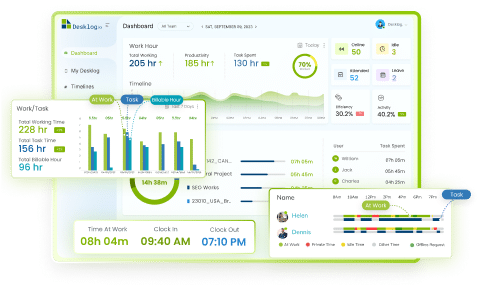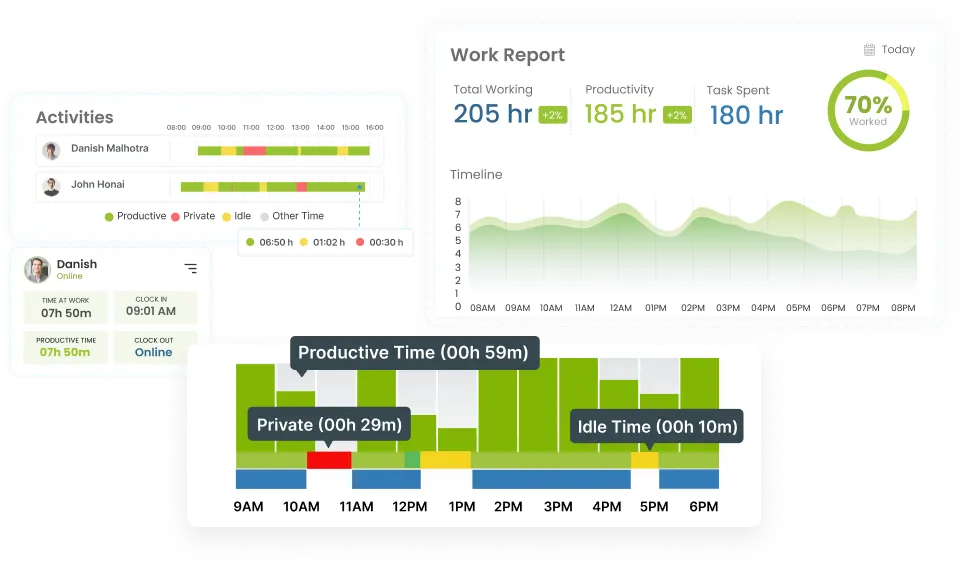According to a survey conducted, nearly half of workers across the globe feel chronically stressed? Juggling work demands with personal lives can feel like an impossible feat. That’s where a well-defined work schedule comes in. A clear understanding of your work hours isn’t just about punching a clock; it’s the key to unlocking a healthy work-life balance and a happier, more productive you. This blog will explore the importance of work schedules for employees and how they can empower you to take charge of your time.
What is Work Schedule?
A work schedule is the time and days of the week in which the employees are required to work. It involves the total hours an employee is assigned, balancing the need to maintain sufficient staffing for the business without overburdening any single individual.
Benefits Of Effective Work Schedules
Effective work schedules are a crucial element in the harmony and productivity of any workplace. They offer a range of benefits that enhance both the operational efficiency of businesses and the job satisfaction of employees.
Here are some key advantages of work schedules for businesses:

Increased Productivity
Effective work schedules align employee working hours with peak productivity times. When employees work at their optimal hours, the quality and quantity of output naturally increase.

Pro Tip
Making a to do list and tracking time for that task can improve productivity in the workplace. Well, check out the blog for other tips to improve productivity.

Improved Employee Morale
A well-planned schedule reflects an organization’s care and respect for its employees. This boosts morale, making employees feel valued and part of a supportive work environment.

Reduced Absenteeism
With a schedule that accommodates personal needs and reduces burnout, employees are less likely to take unscheduled leave. This reliability in attendance contributes to smoother business operations.
Now let us look at some significant benefits that work schedules offer to employees:

Better Work-Life Balance
Schedules that consider personal commitments foster a healthier balance between work and personal life. Employees can effectively manage family time, hobbies, and relaxation, leading to a more fulfilling life.

Improved Mental and Physical Health
Overwork and constant stress are detrimental to health. A well-structured schedule allows for sufficient rest and personal time, reducing stress and improving overall health.

Pro Tip
Implementing time notification features are one of the best ways to maintain a healthy work life and to improve employee well being.

Increased Job Satisfaction
When employees have control over their schedules or work during their most productive hours, they tend to be more engaged and satisfied with their jobs. This leads to higher motivation and a greater sense of accomplishment.
Types Of Work Schedules
The modern workplace offers a variety of work schedules, catering to the diverse needs and lifestyles of employees. These schedules range from traditional nine-to-five routines to more flexible arrangements, reflecting the evolving nature of work in today’s world. Understanding the different types of work schedules can help both employers and employees find the best fit for their work-life balance and productivity needs. Here are some common types of work schedules:
- 1. 2-2-3 Shift Schedule
- 2. Dupont Shift Schedule
- 3. 4-10 Shift Schedule
- 4. 9-80 Shift Schedule
- 5. Flexible Schedules
- 6. Full-Time
- 7. Part-Time
- 8. Overtime Schedule
- 9. Rotating Shift Schedule
- 10. Split Shifts
- 11. On-call Schedules
- 12. Compressed Work Schedule
- 13. Irregular Shift Schedule
- 14. Freelance Schedule
- 15. Seasonal Schedule
Now, let’s explore each type of work schedule more closely.
1. 2-2-3 Shift Schedule
2 2 3 work schedule, also known as Panama schedule, is a type of rotating shift schedule. 2-2-3 work schedules work by working two consecutive days, have two days off, work three days, and the cycle repeats with two days off. This schedule requires 4 teams to complete and to cover a 24 hour cycle.
How it Works
The scheduling system entails employees working two consecutive days, followed by two days off, and then working three consecutive days, with this cycle repeating every two weeks. Typically, these shifts are structured as 12-hour workdays, ensuring continuous coverage throughout the week.
Pros

Predictable schedule pattern.

Allows for every other weekend off.
Cons

Working three consecutive days can be exhausting.

Rotating days off can disrupt personal schedules.
2. Dupont Shift Schedule
Dupont Shift Schedule is a rotating shift schedule that uses four teams to cover 24-hour operations in a 4 week cycle. Each team works a sequence of day and night shifts followed by days off.
How it Works
Four teams are required to rotate through a sequence of shifts, each lasting 12 hours, encompassing both day and night schedules. Each team takes turns fulfilling their designated shifts, allowing for a balanced distribution of workload.
Pros

Extended time off after shift sequences.

Allows for 24/7 operations.
Cons

Long 12-hour shifts can be taxing.

Rapid shift changes can disrupt sleep patterns.
3. 4-10 Shift Schedule
In the 4/10 work schedule, employees work four days a week for 10 hours each day, followed by three days off. The whole 40 hour workweek is compressed into 4 days, making this schedule also known as a compressed schedule.
How it Works
In this work week arrangement, employees are scheduled for four extended workdays, each spanning 10 hours. With this structure, employees work four days a week, completing their tasks within longer shifts. The schedule facilitates enjoying a three day weekend, offering ample time for relaxation, leisure activities, and spending quality time with family and friends.
Pros

Longer weekends for personal activities.

Reduced commuting days.
Cons

Long workdays can be tiring.

Less overlap with other employees can impact collaboration.
4. 9-80 Shift Schedule
In this work schedule, employees work for 8 nine-hour days, one eight-hour day, for a 2 week cycle. To put it simply, in a 9/80 work schedule, employees work for a total of 80 hours over 9 days, instead of ten.
How it Works
Employees working in a 9-80 schedule work under 10 hours in a day. In the first week, employees work a full five-day week, with the first four days consisting of nine-hour shifts. On Friday of that week, the workday is shortened to eight hours. In the next week, employees follow a similar pattern, with four nine-hour workdays, but instead of working on Friday, they have the day off.
Pros

Every other week, employees enjoy a three-day weekend.

Consistent work hours each day.
Cons

Longer working days for most of the week.

Can be complex to manage for employers.
5. Flexible Schedules
Flexible work schedules is a work schedule where employees have the freedom to choose the work hours and days. Here, an employee can choose to work from 10 AM to 6 PM instead of the standard 9-to-5.
How it Works
Employees are required to adhere to a core period of mandatory presence, during which their presence at work is essential. However, the start and end times of the workday can be adjusted around this core period to accommodate individual preferences and organizational needs.
Pros

Encourages work-life balance.

Can increase employee satisfaction and productivity.
Cons

May create coordination challenges.

Not suitable for all job types or industries.
6. Full-Time
Full time work schedule is a standard employment time where individuals work 37 to 40 work hours per week. They may work five 8 hour days, four 10-hour days, or six 6.5-hour days.
How it Works
This work schedule involves a weekly distribution ranging from 35 to 40 hours, providing a stable foundation for employees’ professional commitments. Within this timeframe, individuals can effectively manage their tasks and responsibilities while maintaining a healthy work-life balance.
Pros

Offers job security and full benefits.

Provides a consistent and predictable schedule.
Cons

Less flexibility in work hours.

Can be challenging to balance with personal life.
7. Part-Time
Part time work schedules are work schedules where individuals work fewer hours than full-time, often without full benefits. Here, employees may work for 4 hours a day. They even work in a rotating shift or the night shift if the business needs that.
How it Works
Part-time employees typically work fewer hours compared to their full-time schedule and also receive lower compensation. In some cases, businesses provide part-time opportunities specifically over the weekends, allowing employees to work outside of the workweek schedule.
Pros

Greater flexibility and work-life balance.

Ideal for students, parents, or those with other commitments.
Cons

Usually comes with reduced benefits.

Lower overall income compared to full-time positions.
8. Overtime Schedule
Overtime schedules are the work hours that exceed the standard workweek. It is specified that these employees must receive overtime pay for hours worked beyond the standard 40 hours in a workweek.
How it Works
Overtime happens when employees work additional hours beyond their regular schedule. To compensate employees for their extra efforts, many employers offer overtime pay at a higher rate than regular hours worked.
Pros

Provides opportunities for extra income.

Can help expedite project completion.
Cons

Can lead to burnout and decreased work-life balance.

Long hours may negatively impact health and personal life.
9. Rotating Shift Schedule
Rotating shifts are scheduled shifts that vary over time. For instance, a customer service representative might alternate between six weeks of day shifts and six weeks of night shifts. Similarly, certain industries work from 7 AM to 3 PM one day, from 3 PM to 11 PM the next, and from 11 PM to 7 AM the following day.
How it Works
Rotating shifts is a practice employed by some organizations to ensure fairness and equity among employees in sharing less desirable shift times. While adjusting to different shift patterns may require some adaptability from employees, the overall effect is often a more balanced distribution of workload and a stronger sense of camaraderie among team members.
Pros

Fair distribution of shift types among employees.

Can offer variety in work routines.
Cons

Can disrupt sleep patterns and personal life.

May lead to increased fatigue and stress.
10. Split Shifts
A split shift is a type of work schedule where an individuals’ work schedule is split into two or more parts during the day. Note that taking breaks for rest or to eat does not count in split. That is, an employee may work from 7 AM to 11 AM and then from 4 PM to 8 PM a day.
How it Works
In a split work schedule, the workday is divided into distinct blocks of time, with breaks between shifts being a common feature. Split-shift employees may have shifts separated by a longer break. For instance, they might work from 7:00 AM to 11:00 AM, followed by a break, and then return for another shift from 5:00 PM to 9:00 PM.
Pros

Allows time for personal tasks or rest between shifts.

Can be beneficial in industries with peak periods at different times of the day.
Cons

Can disrupt work-life balance.

Long days when considering total time from first to last shift.
11. On-call Schedules
On call schedules or otherwise called an on call shift is a schedule where employees are on standby to work as needed. This schedule ensures the right employees are available promptly on the call. For instance, on-call doctors should be readily available when medical emergencies emerge.
How it Works
On-call schedules are a common practice in various industries such as healthcare, IT, and emergency services, where employees must be available to respond to urgent situations even when they are not physically at work. To ensure fairness and prevent burnout, employees rotate on-call duties, ensuring that the burden is evenly distributed among team members.
Pros

Flexible as actual work hours may be less than a regular shift.

Can receive additional pay for being on-call.
Cons

Unpredictable work hours.

Can interfere with personal life and plans.
12. Compressed Work Schedule
Compressed work schedule is a type of work schedule which allows employees to complete their work week in fewer days. To put it simply, employees complete their standard 40-hour workweek in four days by working 10-hour shifts each day.
How it Works
A typical characteristic of compressed workweek schedules involves employees working full-time hours over fewer days than the traditional five-day workweek. Common formats for compressed workweeks include the 4/10 schedule, where employees work four 10-hour days per week, and the 9/80 schedule, where employees work 80 hours over nine days, typically resulting in eight 9-hour days and one 8-hour day within a two-week period.
Pros

Longer weekends or additional days off.

Reduced commuting time and expenses.
Cons

Longer work days can be tiring and reduce concentration.

May not suit all job roles or employee preferences.
13. Irregular Shift Schedule
An irregular work schedule is a work schedule that varies the shift day by day and week by week. However, this shift has a negative impact on employees as it becomes daunting to plan and budget their personal lives. The employees are never aware of their upcoming work hours for the following week.
How it Works
Irregular shifts lack consistency as employees’ work hours and days off change on a weekly basis. With no fixed schedule in place, shifts can vary frequently, often based on the immediate needs of the employer rather than the preferences of the employees. This dynamic scheduling approach may pose challenges for workers in terms of planning personal commitments and maintaining a healthy work-life balance.
Pros

Can provide more hours for those seeking extra work.

May suit those with flexible personal schedules.
Cons

Difficulty in planning personal activities due to unpredictable work hours.

Can lead to inconsistent income and work-life balance issues.
14. Freelance Schedule
A freelance schedule refers to the work arrangement adopted by self-employed individuals who operate on a project-to-project basis, typically exerting control over their own work hours and timetable. For freelancers, accommodate varying workloads with flexible scheduling and maintain a work-life balance.
How it Works
Freelancers operate autonomously, sourcing and completing work projects independently. Unlike traditional employees, freelancers have the flexibility to determine their own work hours, which are often dictated by project deadlines and their personal work style.
Pros

High degree of flexibility and independence

Ability to choose projects and clients.
Cons

Unpredictable workflow and income.

Lack of traditional employment benefits and job security.
15. Seasonal Schedule
These schedules occur during a specific season or time of the year. This could last only for 6 months within each calendar year.
How it Works
Work availability often coincides with peak seasons in specific industries, leading to temporary employment tied to seasonal fluctuations. In sectors such as tourism, agriculture, retail, and hospitality, demand surges during particular times of the year, necessitating additional workforce support to meet heightened consumer needs. However, they may also come with uncertainties, as employment duration is typically linked to the duration of the busy season.
Pros

Opportunity for additional income during peak seasons.

Suitable for students or those seeking short-term employment.
Cons

Lack of work outside the specific season.

May not provide sufficient income year-round.
How To Create A Work Schedule?
Creating an effective work schedule involves several steps to ensure it meets both the business’s needs and employees’ preferences. Here are the key steps to consider:
Understand Employee Needs
It’s important to know your employees’ personal commitments and preferences. This understanding helps in creating schedules that accommodate their lives outside of work, which can lead to increased job satisfaction and productivity.
Example: A parent might request early shifts to align with school hours for their children. Acknowledging this and scheduling them for morning shifts can enhance their work-life balance.
Consider Business Requirements
Analyze the demands of your business, including peak hours and slower periods. Tailoring the work schedule to these needs ensures optimal staffing during critical times, while also maintaining operational efficiency.
Example: A retail store may require more staff during holiday seasons. The manager should plan for increased staffing during these peak times while balancing employee availability and preferences.
Offer Different Schedule Types
Providing a variety of schedule types, such as full-time, part-time, or flex-time, caters to diverse employee needs. This approach can attract a broader range of talent and helps retain employees by offering options that fit different lifestyles and life stages.
Example: A tech company could offer standard 9-to-5 schedules, four-day workweeks, or remote work options, catering to diverse employee preferences and lifestyles.
Use Scheduling Software
Implementing scheduling software streamlines the process, making it easier to manage and modify schedules. These tools can handle complex scheduling tasks, offer visibility to employees, and reduce the likelihood of errors.
Example: A restaurant manager uses software to input employee availability, manage shift swaps seamlessly, and ensure equal distribution of weekend and evening shifts.
Plan for Overlap
Schedule overlap periods during shifts to ensure smooth transitions. This practice helps in information sharing between incoming and outgoing staff, and maintains continuity in tasks without sacrificing productivity.
Example: In a hospital, nurse shifts might be scheduled to overlap for 30 minutes to allow for proper patient handover and to ensure continuous care.
Prioritize Work-Life Balance
Create schedules that promote a healthy balance between work and personal time. This approach can reduce burnout and improve overall employee well-being, which in turn can boost morale and productivity.
Example: A call center avoids scheduling employees for back-to-back late-night shifts and ensures each employee has at least two consecutive days off per week to rest.
Communicate Clearly
Ensure that all employees understand their schedules well in advance. Clear communication about scheduling prevents misunderstandings and allows employees to plan their personal time effectively.
Example: A construction company releases work schedules two weeks in advance through an online portal, allowing workers to plan their personal commitments around their work hours.
Allow for Flexibility
Incorporating flexibility in scheduling can help accommodate unexpected employee needs and adapt to changes in business demand. This flexibility can increase employee loyalty and reduce turnover.
Example: When an employee at a law firm has a personal emergency, their manager promptly rearranges the schedule, allowing colleagues to cover or swap shifts without disrupting operations.
Rotate Unpopular Shifts
Fairly rotate less desirable shifts among employees. This rotation prevents burnout and resentment, promoting a sense of fairness and equality within the team.
Example: In a 24/7 customer support team, the manager rotates the overnight shifts among all team members, ensuring no single employee is consistently stuck with undesirable hours.
Regularly Review and Adjust
Continuously assess and adjust schedules based on feedback and changing requirements. Regular reviews ensure that the scheduling process remains effective and responsive to both employee and business needs.
Example: A marketing agency conducts quarterly reviews of their scheduling process, taking into account employee feedback and changing project demands, and adjusts schedules accordingly for optimal performance and satisfaction.
Each of these examples demonstrates a practical approach to balancing the needs of the business with the well-being and preferences of employees, leading to a more harmonious and productive workplace.
How Do Work Schedules Help Employees?
Work schedules are not just organizational tools; they are key to empowering employees in both their professional and personal spheres. Let’s explore how these schedules contribute to an employee’s well-being and efficiency:

Plan Their Days
With a defined work schedule, employees can organize their day-to-day activities effectively. This clarity allows them to prioritize and keep backlogs of work tasks, leading to better management of their responsibilities.

Improved Productivity
Regular work schedules ensure that employees are working during their optimal hours. Being well-rested and mentally prepared for the workday boosts their concentration and efficiency, leading to higher productivity and quality of work.

Reduce Stress
A predictable work schedule provides employees with the ability to plan their life outside work. This foresight helps in minimizing the anxiety and stress that can come from juggling professional and personal duties.

Improve Work-Life Balance
Structured working hours allow employees to maintain a healthy balance between their job and personal life. This equilibrium is crucial for their overall well-being, reducing burnout and increasing job satisfaction.

Encourages Professional Growth
Set work hours offer employees the opportunity to schedule time for career development activities, such as training and learning new skills. This not only enhances their current performance but also paves the way for future advancement.

Fosters Better Health Habits
Regular work schedules can promote healthier lifestyle choices. Employees with a routine are more likely to find time for exercise, proper meals, and sufficient rest, contributing to better physical and mental health.
Employee Scheduling And Time-Tracking Software
The integration of employee scheduling and time tracking software represents a significant advancement in tracking and managing employee schedules. By combining these two functions, businesses can achieve a more streamlined, efficient approach to managing employee hours.
This integration allows for real-time tracking of hours worked, which is seamlessly aligned with pre-established work schedules, ensuring accuracy in invoicing & billing processing and labor regulation compliance. It also provides valuable insights into
- Staffing needs
- Employee availability
- Overtime management
This ultimately leads to better resource allocation and increased operational efficiency.
What Is An Employee Scheduling Software?
Employee scheduling software is an automated tool that streamlines the creation and management of employee schedules. By analyzing insights into operational dynamics and resource availability, this software streamlines scheduling processes, balancing shift rules, work hours, breaks, off times, demand forecasting, and skill requirements. This automation significantly boosts productivity and enables organizations with hourly workforces to redirect resources to other essential tasks beyond scheduling duties.
Desklog is an excellent example of such software, often hailed as a “super” employee scheduling software due to its comprehensive features and user-friendly interface. Desklog’s capabilities extend beyond mere scheduling, making it an all-encompassing tool for managing various aspects of workforce productivity.
Key features of Desklog include:

Automated Scheduling
Desklog allows managers to create and distribute employee schedules with ease. The automation feature ensures that the process is fast, accurate, and free from conflicts.

Real-Time Tracking
One of the standout features of Desklog is its real-time tracking capability. Managers can track employee attendance, work hours, and breaks in real-time, ensuring adherence to the schedule.

Project Tracking
Desklog is not limited to just tracking hours. It also enables project tracking. Managers can assign tasks and track the progress of projects, aligning them with the employee’s schedules.

Time Tracking
Integrated time tracking allows for precise recording of hours worked by each employee, which is crucial for payroll processing and tracking overall productivity.

Reports and Analytics
Desklog provides detailed reports and analytics, offering insights into employee performance evaluation, productivity trends, and potential areas for improvement.

Leave Management
The software includes a leave management system, where employees can request time off, and managers can approve or decline these requests based on workforce availability.

User-friendly Interface
Despite its robust functionality, Desklog boasts a user-friendly interface, making it accessible for both managers and employees, enhancing the overall user experience.

Flexibility
Desklog caters to a variety of business sizes and types, offering flexibility in terms of customizing features to suit specific organizational needs.
Desklog stands out as an excellent employee scheduling software not only because of its extensive range of features but also due to its emphasis on enhancing productivity and simplifying employee time tracking. By integrating various aspects of employee management into a single platform, Desklog represents a holistic approach to scheduling and workforce optimization.
Final Thoughts
A well-crafted work schedule is a roadmap to a healthier, more productive you. By providing structure and predictability, it empowers you to manage your time effectively, reduce stress, and achieve a work-life balance that fuels your personal well-being. As the workplace continues to evolve, the role of adaptive and thoughtful scheduling remains integral to the success of both employees and organizations.
Remember, a happy employee is a productive employee! 😀
FAQ
1What should be in a work schedule?
When making employee schedules, it’s important to include:
- Work dates and times
- Job description
- Tasks and responsibilities
- Expected work hours
- Locations
2What defines a work schedule?
A work schedule is a plan that outlines the specific days and hours an employee is expected to work. It provides a structured framework for work time, ensuring organized and efficient operations.
3Is a work schedule the same as a shift pattern?
A work schedule includes shift patterns but is broader, encompassing the total hours, days, and specific times an employee works, whereas a shift pattern refers to the recurring sequence of work hours.
4How does a work schedule differ from part-time to full-time employment?
Full-time work schedules typically involve a greater number of hours and more consistent workdays, while part-time schedules offer fewer hours and can be more varied in terms of days and times.
5Can a work schedule be flexible?
Yes, flexible work schedules allow employees to vary their arrival and departure times, providing adaptability to meet both business and personal needs.
6What is a fixed work schedule?
A fixed work schedule has consistent days and hours of work each week. This schedule is predictable and does not change from week to week.
7How are work schedules important for businesses?
Work schedules ensure that a business is adequately staffed at all times, enhancing productivity and meeting operational demands efficiently.
8Can employees have a say in their work schedules?
Many businesses allow employees to have input into their work schedules, promoting a better work-life balance and increased job satisfaction.
9What is a rotating work schedule?
A rotating work schedule involves varying work days and hours, typically changing week to week, allowing businesses to cover various shifts while giving employees varied work hours.
10How do work schedules impact employee well-being?
Work schedules greatly influence an employee’s work-life balance, job satisfaction, and overall well-being, making it crucial for employers to consider individual needs and preferences.
















